In 2014, the DMA acquired a large collection of contemporary southwest Native American ceramics, the gift of Dr. and Mrs. Robert I. Kramer. The collection consists of works by over 65 contemporary artists, many of whom have been honored at prestigious art shows such as the Santa Fe Indian Market.
Many of these vessels were created by two artists—a potter and a painter—who worked together on the final design, form, and decoration. Pottery making is an engaging social activity for family members or close friends, and in many of the Pueblos, the legacy of fine pottery can be traced to an individual or a family. Maria Martinez of San Ildefonso and her family were instrumental in furthering the millennia-old tradition of pottery making during a time of cultural and artistic transition due to the newly established railroad in Santa Fe, which brought the tourist trade, manufactured goods, and a market economy to the Pueblos.
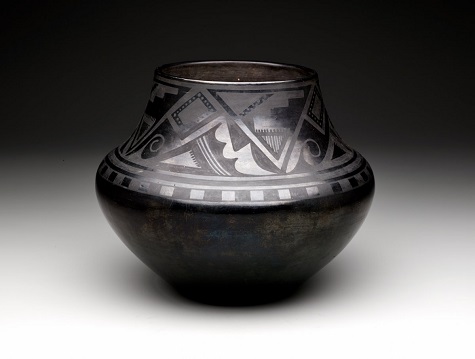
Maria Martinez and Julian Martinez, Black-on-black jar with geometric designs, c. 1920, ceramic, Dallas Museum of Art, The Otis and Velma Davis Dozier Fund, 2014.26.3
Made in collaboration with her husband, this black-on-black jar with Julian’s expertly painted abstract and geometric designs was a typical form for Maria Martinez, illustrating her artistic departure from traditional forms. While reminiscent of larger ollas, this piece has a more elongated and gently sloping neck and a stouter base, producing a sharper shoulder. Its smaller size also made it more appealing to early 20th-century tourists and collectors, as it could be acquired at a lower price and was easier to transport. The nearly metallic sheen alludes to their son Popovi Da’s later innovation, a gunmetal finish he developed in the 1960s by increasing the firing time of the black-on-black method perfected by Maria and Julian.
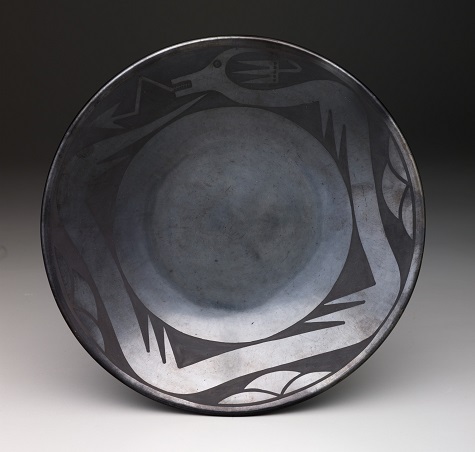
Maria Martinez and Santana Martinez, Plate with avanyu design, 1943-1956, ceramic, Dallas Museum of Art, Foundation for the Arts Collection, gift of Mr. and Mrs. Duncan E. Boeckman, 1987.343.FA
If you’ve visited the Native American Gallery on Level 4, you might have seen other exceptional works by the Martinez family. This plate made by Maria and her daughter-in-law Santana highlights the avanyu design created in the early 20th century by Julian Martinez. It was based on depictions occurring on rock art near springs and on ancient vessels. The avanyu is a water deity who, if angered, can cause floods, droughts, landslides, or earthquakes. Representing a thunderstorm and surrounded by clouds, this horned serpent has an undulating body and a tongue reminiscent of a lightning bolt.
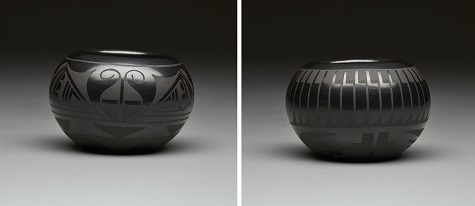
Marvin and Frances Martinez, Black-on-black bowl with feather motif, late 20th century, ceramic, Dallas Museum of Art, gift of Dr. and Mrs. Robert I. Kramer, 2014.43.63 (not currently on view)
This small pot from the Kramer collection further demonstrates familial collaborations and traditional forms. It was made by the husband and wife team of Marvin and Frances Martinez. Marvin is the grandson of Adam and Santana Martinez and the great-grandson of Maria and Julian. The bowl exhibits the signature black-on-black style for which Maria and her family are so well known and bears a stylized butterfly design and the familiar feather pattern drawn from ancient Mimbres vessels in the early 20th century.
The DMA has a comparable Mimbres vessel with a radiating feather pattern currently on view:
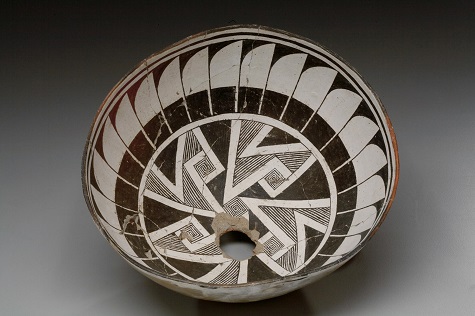
Mogollon (Mimbres) culture, Bowl with geometric composition and design of radiating feathers, c. 1000-1150, ceramic and slip paints, Dallas Museum of Art, gift of Elizabeth and Duncan Boeckman, 2011.45
Across the gallery from the Mimbres bowl is another example of the radiating feather motif, a plate made by Maria and her son Popovi Da in the 1960s:
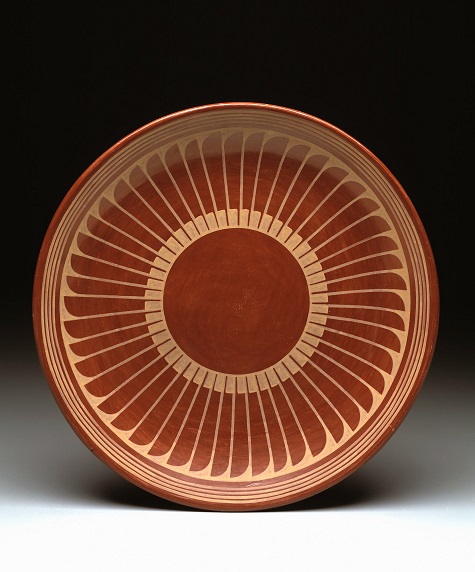
Maria Martinez and Popovi Da, Plate with radiating feather design, 1960s, ceramic, Dallas Museum of Art, Foundation for the Arts Collection, anonymous gift, 1987.342.FA
Maria began collaborating with her son in 1956. Popovi Da was an artist in his own right, adding many creative innovations to the Martinez family tradition such as a dual-toned black-and-sienna finish and the use of turquoise.
The DMA is fortunate to have the opportunity to make these fun and fascinating connections between families of artists.
Amanda Kramp is the McDermott Graduate Intern for Ancient American Art at the DMA.